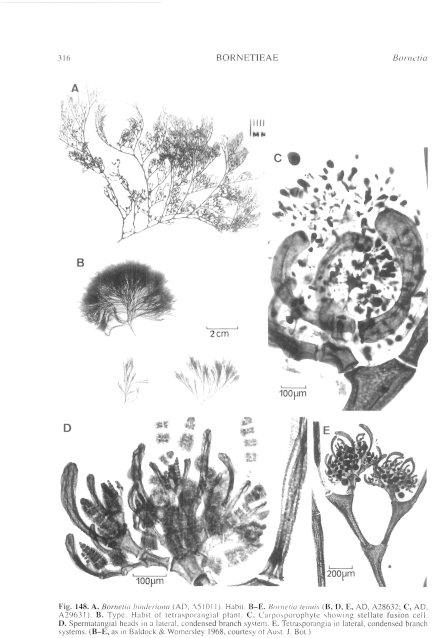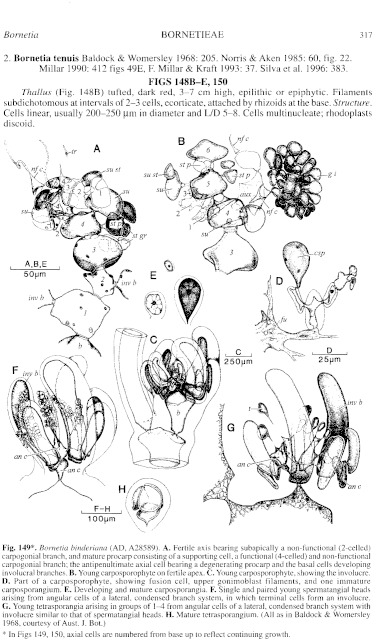|
|
|
|
|
|||||||||||
|
Electronic Flora of South Australia Species Fact Sheet
Phylum Rhodophyta – Order Ceramiales – Family Ceramiaceae – Tribe Bornetieae
Selected citations: J. Agardh 1876: 613. Baldock & Womersley 1968: 201, figs 5–12, pl. 1 fig. 2. De Toni 1903: 1296.
Synonyms
Huismann & Walker 1990: 419. Lucas 1909: 48. Lucas & Perrin 1947: 327, fig. 158. May 1965: 367. Silva et al. 1996: 383. Sonder 1881: 28.
Griffithsia binderiana Sonder 1845: 52; 1848: 168. J. Agardh 1851: 86. Harvey 1855a: 559; 1858 : pl. 52; 1863, synop.: 1. Kützing 1849: 660; 1862: 8, pl. 25a–c. Tisdall 1898: 502.
Thallus (Fig. 148A) light to medium red, 3–9 (–13) cm high, lax and fl abell ate, subdichotomously and mostly unilaterally branched at intervals of 1–2 cells, more distantly near the base. Attachment by an erect basal cell which in some plants produces short rhizoidal cells. Structure. Upper cells 500–900 µm in diameter and L/D 2–3, lower cells 600–700 µm in diameter and L/D 2–4. Cells multinucleate: rhodoplasts discoid.
Reproduction: Gametophytes dioecious. Female axis of 6–8 small cells (Fig. 149A) borne on a larger basal cell containing crystalline inclusions, arising adaxially in the position of a lateral branch; involucral branches arising from the larger basal and lower 2 small cells of the fertile axis in a 1/4 spiral pattern, unbranched or subdichotomously branched once; basal involucral cells oblong, radiating horizontally, bearing 1 (–2) erect, elongate, incurved cells terminally, producing a basket-shaped condensed branch system (Fig. 149C); 2 (–3) procarp systems produced successively from subapical cells in a 1/4 spiral pattern, each consisting of 1 (–2) periaxial sterile cell(s) often developing into 2-celled non-functional carpogonial branch(es), and a supporting cell bearing a lateral, recurved, 4-celled carpogonial branch and apically a sterile cell or a non-functional 2-celled carpogonial branch. Following fertilization in the first formed (lowest) procarp system, the supporting cell divides to form an auxiliary cell (Fig. 149B) which is intercalated between the non-functional carpogonial branch and residual supporting cell (see Baldock & Womersley 1969, p. 200) and this divides forming 1–2 gonimolobes. Fusion cell stellate, 200–270 µm across, produced from the auxiliary cell and densely branched lower gonimoblast cells; carposporangia (Fig. 149D, E), granular, ovoid-lachrimiform, 42–55 µm in diameter and L/D 1.6–2, with several vacuoles radiating from a single, central nucleus, borne at first on subdichotomous chains of cells, ultimately at the end of slender processes from the fusion cell (Fig. 149D). Spermatangial heads, sessile, elongate, 130–140 µm in diameter and L/D 2.5–3, single (–2) and apical on 3 (–5) small angular cells which branch laterally in a 1/4 spiral pattern producing a further angular cell and 1 (–3) large elongate, incurved involucral cells resulting in a basket-shaped, compressed branch system (Fig. 149F); heads not exceeding the length of the involucre.
Tetrasporangia sessile, in clusters of 2–4, borne in comparable positions to spermatangial heads in similar condensed lateral branch systems with a 1/4 spiral branching pattern (Fig. 149G), the terminal cells of which form incurved involucres; sporangia ovoid, 53–85 µm in diameter, tetrahedrally divided (Fig 149H).
Type from W. Aust. (probably near Fremantle)(Preiss); lectotype in MEL, 502123 from "Swan River".
Selected specimens: Point Peron, W. Aust., on Vidalia spiralis, drift (Cribb 69.4, 15.viii.1950; AD, A13937), and drift (Womersley, 18.viii.1979; AD, A51011). Whitfords Beach, 24 km N of Perth, W. Aust., on Codium galeatum, 6 m deep (Kirkman, 16.viii.1979; AD, A50558) and on Vidalia intermedia, drift (Royce, 26.v.1951; AD, A16241). Cottesloe Beach, W. Aust., on various fucoids, drift (Smith, June 1964; AD, A28996). D'Entrecasteaux Reef, Great Australian Bight, S. Aust., on Mychodea, 15–20 m deep (Shepherd, 27.iii.1980; AD, A52164). Seal Bay, Kangaroo I., S. Aust., on Brongniartella and Thysanocladia oppositifolia, drift (Baldock, 21.i.1965; AD, A28589). Carpenter Rocks, S. Aust., on Thysanocladia laxa, 3–4 m deep (Shepherd, 4.xii.1968; AD, A33117). San Remo back beach, Vic., on Caulerpa brownii, drift (Sinkora A1949, 5.xii.1974; AD, A62651).
Distribution: Champion Bay, W. Aust. (Huisman & Walker 1990, p. 419) to Port Phillip, Victoria, usually epiphytic on red algae at moderate depths.
Taxonomic notes: Abbott (1946, p. 442) credited B. binderiana (as Griffithsia) to the Hawaiian Islands, and Dawson (1961, p. 417) recorded it from El Salvador. These records refer to a species of Griffithsia. The record of Børgesen (1945, p. 16) for Mauritius is also doubtful and the specimen needs checking.
References:
ABBOTT, I.A. (1946). The genus Griffithsia (Rhodophyceae) in Hawaii. Farlowia 2(4), 439–453.
AGARDH, J.G. (1851). Species Genera et Ordines Algarum. Vol. 2, Part 1, I-XII, 1–336 + index. (Gleerup: Lund.)
AGARDH, J.G. (1876). Species Genera et Ordines Algarum. Vol. 3, Part 1- Epicrisis systematic Floridearum, pp. i-vii, 1–724. (Weigel: Leipzig.)
BØRGESEN, F. (1945). Some marine algae from Mauritius III. Rhodophyceae. Part 4 Ceramiales. K. Dan. Vidensk. Selsk. Biol. Meddr. 19(10), 1–68.
BALDOCK, R.N. & WOMERSLEY, H.B.S. (1968). The genus Bornetia (Rhodophyta, Ceramiaceae) and its southern Australian representatives, with a description of Involucrana gen. nov. Aust. J. Bot. 16, 197–216, Plates 1–4.
DAWSON, E.Y. (1961). Plantas marinas de la zona de las mareas de el Salvador. Pacif. Nat. 2(8), 389–461.
DE TONI, G.B. (1903). Sylloge Algarum omnium hucusque Cognitarum. Vol. 4. Florideae. Sect. 3, pp. 775–1521 + 1523–1525. (Padua.)
HARVEY, W.H. (1855a). Some account of the marine botany of the colony of Western Australia. Trans. R. Jr. Acad. 22, 525–566.
HARVEY, W.H. (1858). Phycologia Australica. Vol. 1, Plates 1–60. (Reeve: London.)
HARVEY, W.H. (1863). Phycologia Australica. Vol. 5, Plates 241–300, synop., pp. i-lxxiii. (Reeve: London.)
HUISMAN, J.M. & WALKER, D.I. (1990). A catalogue of the marine plants of Rottnest Island, Western Australia, with notes on their distribution and biogeography. Kingia 1, 349–459.
KÜTZING, F.T. (1849). Species Algarum. (Leipzig.)
KÜTZING, F.T. (1862). Tabulae Phycologicae. Vol 12. (Nordhausen.)
LUCAS, A.H.S. & PERRIN, F. (1947). The Seaweeds of South Australia. Part 2. The Red Seaweeds. (Govt Printer: Adelaide.)
LUCAS, A.H.S. (1909). Revised list of the Fucoideae and Florideae of Australia. Proc. Linn. Soc. N.S.W. 34, 9–60.
MAY, V. (1965). A census and key to the species of Rhodophyceae (red algae) recorded from Australia. Contr. N.S.W. natn. Herb. 3, 349–429.
SONDER, O.G. (1845). Nova Algarum genera et species, quas in itinere ad oras occidentales Novae Hollandiae, collegit L. Preiss, Ph.Dr. Bot. Zeit. 3, 49–57.
SONDER, O.W. (1848). Algae. In Lehmann, C., Plantae Preissianae. Vol. 2, pp. 161–195. (Hamburg.)
SONDER, O.W. (1881). In Mueller, F., Fragmenta Phytographiae Australiae. Supplementum ad volumen undecinum: Algae Australianae hactenus cognitae, pp. 1–42, 105–107. (Melbourne.)
TISDALL, H.T. (1898). The algae of Victoria. Rep. 7th Meet. Aust. Ass. Adv. Sci., Sydney, 1898, pp. 493–516.
ZANARDINI, G. (1865). Bornetia secundiflora (J. Ag) Thur. Iconographia phycologica Mediterranea-Adriatica, Vol. 2, 43–46, Plate 51.
The Marine Benthic Flora of Southern Australia Part IIIC complete list of references.
Publication:
Womersley, H.B.S. (24 December, 1998)
The Marine Benthic Flora of Southern Australia
Rhodophyta. Part IIIC. Ceramiales – Ceramiaceae, Dasyaceae
©State Herbarium of South Australia, Government of South Australia
Illustrations in Womersley Part IIIA, 1998: FIGS 148A, 149.

Figure 148 enlarge
Fig. 148. A. Bornetia binderiana (AD, A51011). Habit. B–E. Bornetia tenuis (B, D, E, AD, A28632; C, AD, A29631). B. Type. Habit of tetrasporangial plant. C. Carposporophyte showing stellate fusion cell. D. Spermatangial heads in a lateral, condensed branch system. E. Tetrasporangia in lateral, condensed branch systems. (B–E, as in Baldock & Womersley 1968, courtesy of Aust. J. Bot.)

Figure 149 enlarge
Fig. 149. Bornetia binderiana (AD, A28589). A. Fertile axis bearing subapically a non-functional (2-celled) carpogonial branch, and mature procarp consisting of a supporting cell, a functional (4-celled) and non-functional carpogonial branch; the antipenultimate axial cell bearing a degenerating procarp and the basal cells developing involucral branches. B. Young carposporophyte on fertile apex. C. Young carposporophyte, showing the involucre. D. Part of a carposporophyte, showing fusion cell, upper gonimoblast filaments, and one immature carposporangium. E. Developing and mature carposporangia. F. Single and paired young spermatangial heads arising from angular cells of a lateral, condensed branch system, in which terminal cells form an involucre. G. Young tetrasporangia arising in groups of 1-4 from angular cells of a lateral, condensed branch system with involucre similar to that of spermatangial heads. H. Mature tetrasporangium. (All as in Baldock & Womersley 1968, courtesy of Aust. J. Bot.)
Note: Axial cells are numbered from base up to reflect continuing growth.

|
Email Contact: State Herbarium of South Australia |

|